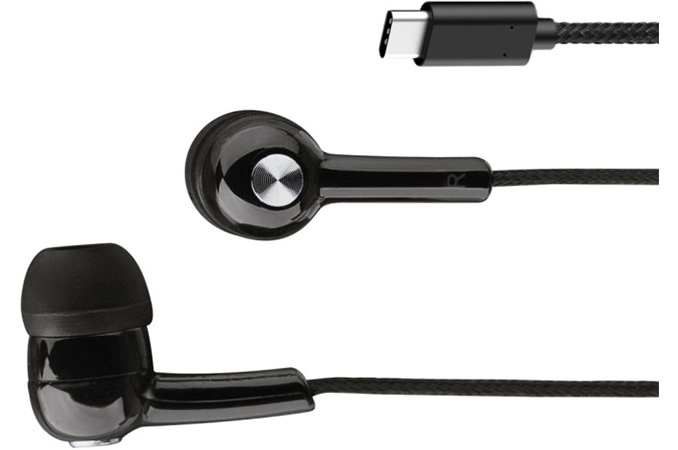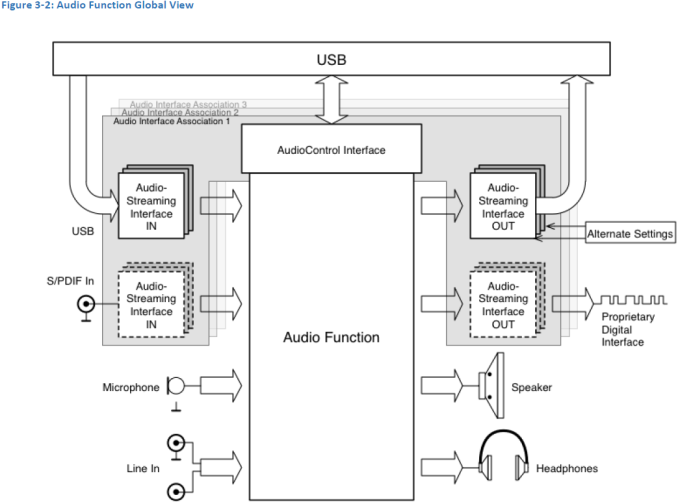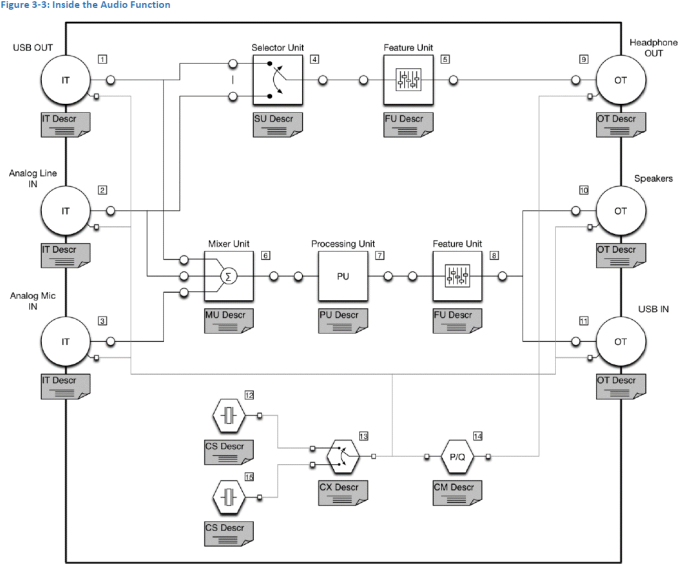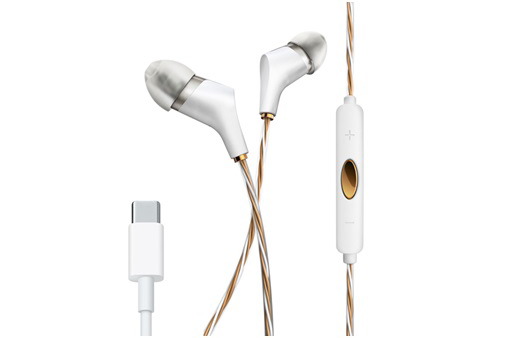USB-IF Publishes Audio over USB Type-C Specifications
by Anton Shilov on September 30, 2016 12:00 PM EST- Posted in
- Mobile
- USB-C
- USB-C Digital Audio

The USB Implementers Forum this week published the USB Audio Device Class 3.0 specification, which standardizes audio over USB Type-C interface. The new spec enables hardware makers to eliminate traditional 3.5mm mini-jacks from their devices and use USB-C ports to connect headsets and other audio equipment. Makers of peripherals can also build their audio solutions, which use USB-C instead of traditional analog connectors. Developers of the standard hope that elimination of mini-jacks will help to make devices slimmer, smarter and less power hungry.
The industry, led by Intel and some other companies, has been mulling about replacing the traditional 3.5mm mini-jack connector for some time now. The main motives for replacement were necessity to simplify internal architecture of devices by removing analog and some audio processing components from the inside (which leads to further miniaturization), minimize the number of external connectors, improve power management as well as to add smart features to headsets and other audio equipment. We discussed USB Type-C Audio Technology briefly earlier this year and mentioned that this is not the first time that the industry has tried to use USB instead of the good-old mini-jack. The important difference between contemporary initiative and attempts in the past is the fact that today the primary goal is to replace the 3.5mm jack in portable devices.
As reported, the USB Audio Device Class 3.0 specification supports both analog and digital audio. Analog audio is easy to implement and it does not impact data transfers and other functionality of USB-C cables since it uses the two secondary bus (SBU) pins. Some device makers may find the analog audio feature of the standard to be a relatively simple way to add certain smart capabilities to their headsets without major redesign of hosts. While analog USB-C audio will not help to shrink dimensions of portables, it could be particularly useful for non-mobile devices, where miniaturization is not crucial, but where port space is at a premium or where additional features either make sense (infotainment, sport equipment, etc.) or are fundamental (VR HMDs).
The USB ADC 3.0 defines minimum interoperability across analog and digital devices in order to avoid confusion of end-users because of incompatibility. In fact, all ADC 3.0-compliant hosts should support the so-called headset adapter devices, which allow to connect analog headsets to USB-C. However, digital audio is one of the primary reasons why companies like Intel wanted to develop the USB-C audio tech in the first place, hence, expect them to promote it.
According to the USB ADC 3.0 standard, digital USB-C headphones will feature special multi-function processing units (MPUs), which will, to a large degree, define the feature set and quality of headsets. The MPUs will handle host and sink synchronization (this is a key challenge for digital USB audio), digital-to-analog conversion, low-latency active noise cancellation, acoustic echo canceling, equalization, microphone automatic gain control, volume control and others. Such chips will also contain programmable amplifiers and pre-amplifiers, which are currently located inside devices. Besides, USB ADC 3.0-compatible MPUs will also support USB Audio Type-III and Type-IV formats (the latest compressed formats), but will retain compatibility with formats supported by ADC 1.0 and 2.0. Finally, among the mandated things set to be supported by USB-C Audio devices are new Power Domains (allows devices to put certain domains in sleep mode when not in use) as well as BADD (basic audio device definition) 3.0 features for saving power and simplified discovery and management of various audio equipment (each type of devices has its own BADD profile).
Over the past few months, Conexant has introduced three USB-C Audio MPUs (1, 2) for headsets, docking stations and other equipment. Assuming that these chips are compliant with the USB ADC 3.0 specs from a hardware standpoint, and the software is ready, actual devices featuring USB-C Audio could arrive in the coming months. Pricing of the first USB ADC 3.0-compliant MPUs is unknown, but in general MPU ICs do not cost too much. Moreover, as developers adopt smaller process technologies and a larger number of such chips hit the market, their prices are going to decline. In the end, it will be interesting to see where digital headphone prices end up. The MPUs will definitely add to the total bill of materials for a set of headphones, but at the same time they add new functionality as well, so the big question is how manufacturers then factor all of that into device pricing.
A number of companies, including Apple and LeEco, have already introduced smartphones that do not use traditional mini-jacks, and Google added support for USB DAC devices to Android over a year ago. The finalization of the USB ADC 3.0 spec, introduction of USB-C audio ICs, as well as design decisions of smartphone makers demonstrate that the industry is trying to eliminate 3.5mm jacks from mobile devices. The big question is whether the rest of the industry plans to do the same. It is true that portables are primary devices for music listening for many people. However, there are tens of applications which still rely on analog connectors, and hundreds of millions of people who use them either to consume or create content. To eradicate 3.5mm jacks completely, USB-C Audio promoters will have to work with thousands of vendors and this takes time. Consequently, it is too early to say that this is the end for the good-old mini-jack.
Images by Conexant, USB IF.
Source: USB IF













93 Comments
View All Comments
MobiusStrip - Saturday, October 1, 2016 - link
Yes, but the ancient 30-pin connector did. That band-aided and patched-together connector also provided better VIDEO than the pathetic Lightning connector, despite never being intended to provide video at all. This is revealing: https://panic.com/blog/the-lightning-digital-av-ad...SeleniumGlow - Monday, October 3, 2016 - link
That link was an interesting read. Thanks for sharing mate.cygnus1 - Thursday, October 6, 2016 - link
Agreed, good read. Especially the anonymous comment that's pointed out at the end. It makes since that there's not that much going on over the lightning port though as it's not much more than just a custom form factor for USB2 port.Azethoth - Saturday, October 1, 2016 - link
On the one hand you are right, they could keep the jack, on the other hand it lets them miniaturize more, on the third hand it leads to a completely wireless phone setup. As someone that plays Pokemon Go (and hopefully soon a quality Blizzard game instead of that crap), I feel and look stupid with headphone wires and charge wires dangling all over the place, and its dumb when I forget and everything goes flying around, including the phone and delicate ear buds.Impulses - Saturday, October 1, 2016 - link
You could already use Bluetooth... This doesn't enable any new form of wireless connectivity.melgross - Saturday, October 1, 2016 - link
In theory at least, Apple electrical standard for this works with Intel's. the different physical plug can be accommodated with a small, cheap adapter.thCRITICALThinker - Friday, September 30, 2016 - link
I'm sure carrying two or three pairs of headphones will be great fun depending on what standard I want to use, the ever present 3.5mm, usb-c or lightning, and heaven forbid I try and listen to my phone while charging.I will boycott any company that doesn't offer a headphone jack on their devices.
cygnus1 - Friday, September 30, 2016 - link
What if they offer dual USB-C ports? Not out of the realm of reason.MobiusStrip - Saturday, October 1, 2016 - link
That is out of the realm of reason, since now they haven't eliminated a port at all. They'd just be replacing the universally usable audio jack with another jack... which doesn't provide audio.__Miguel_ - Monday, October 3, 2016 - link
I've talked about this before. Two ports will be a mess. And potentially more expensive than 1 port plus a 3.5mm jack. Not to mention that, while slimmer, the USB-C port still takes up a larger footprint than the 3.5mm one, so that alone would make the transition a wash. AND, to make things even funnier, you'll still need to have an internal DAC, to handle analog audio over USB-C, so you'll be increasing prices, not decreasing them...Also, USB-C requires each port to be wired in accordance to the services provided by the port. So, either you'll wire all available ports to provide video out, plus USB audio, plus whatever USB alt-modes you're implementing (and good luck trying to route all those traces all over the phone, or multiplying the extra hardware to provide the services on far-away ports), or the consumer will be baffled by why he can't use port A for audio, since USB-C is supposed to be universal, or return the headphones or phone as broken because he can't use one of the ports for audio output.
Seriously, dropping the 3.5mm jack is a colossal mistake. The only advantage here is for headphone manufacturers, USB-C to 3.5mm adapter manufacturers, and phone manufacturers, who will jack prices up even more, because "shiny new thing".
In the meanwhile, consumers will get shorter battery times, pay more for stuff, risk having their USB-C ports shot to hell by shady 3rd-party USB-C headphones, potentially have crappier sound than even before, because it's more complicated to build active headphones than passive ones, and benefit exactly zero from the supposed "digital" sound: normal headphones are too small for people to notice any difference, and really high-end users don't rely on internal DACs anyway, they've been using USB external DACs for years...
So, yeah... I'm not bashing USB-C audio just because. As flawed as the 3.5mm jack might be, after weighing the pros and the cons, it's still miles ahead from USB-C. At least not right now, and not in the next half a decade, either.